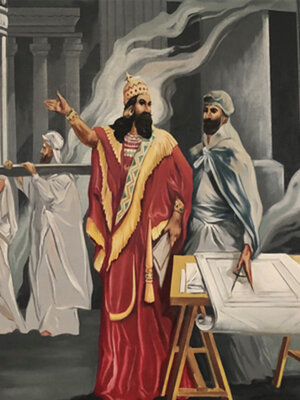
Sign up to save your library
With an OverDrive account, you can save your favorite libraries for at-a-glance information about availability. Find out more about OverDrive accounts.
Find this title in Libby, the library reading app by OverDrive.



Search for a digital library with this title
Title found at these libraries:
| Library Name | Distance |
|---|---|
| Loading... |
Hiram Abif is a legendary figure in Masonic tradition, central to the allegory and teachings of Freemasonry. While he is not explicitly mentioned in the historical or biblical accounts of the construction of King Solomon's Temple, his character is derived from the biblical figure of Hiram, the master craftsman mentioned in 1 Kings 7:13–14 and 2 Chronicles 2:13–14. Here's an explanation of both the biblical and Masonic perspectives:
Biblical Account
In the Bible, Hiram (also called Huram) is described as a skilled artisan from Tyre, sent by King Hiram of Tyre to assist King Solomon in building the Temple in Jerusalem. He was:
The son of a widow from the tribe of Naphtali and his father was a man of Tyre, skilled in working with bronze.
Renowned for his expertise in metalwork, he created many of the Temple's furnishings, including the two bronze pillars (Jachin and Boaz), the bronze sea, and various other intricate designs and implements.
Masonic Legend
In Freemasonry, Hiram Abif is a symbolic figure representing the archetype of the master craftsman. His story is central to the rituals of the third (Master Mason) degree and serves as a moral and philosophical allegory. According to Masonic tradition:
Hiram Abif was the chief architect and builder of King Solomon's Temple.
He possessed great skill and was entrusted with the secrets of the master craftsman.
The legend recounts his tragic death at the hands of three ruffians (known as Jubela, Jubelo, and Jubelum), who sought to force him to reveal the master's word (symbolizing secret knowledge or wisdom). Despite threats and ultimately violence, Hiram remained steadfast and refused to betray his trust, thus dying as a martyr to duty, integrity, and fidelity.
Symbolic Role in Freemasonry
Hiram Abif's story serves as an allegory for:
Integrity and Sacrifice: His unwavering commitment to his principles underlines the importance of fidelity to one's moral and ethical values.
Death and Resurrection: The legend symbolizes the idea of spiritual rebirth and the immortality of the soul. The dramatic events of his death and "raising" in Masonic ritual represent personal transformation and the pursuit of higher knowledge.
Wisdom and Craftsmanship: Hiram's role reflects the virtues of skill, dedication, and mastery in one's work, aligning with the values of Freemasonry.
While Hiram Abif is a fictionalized figure in Freemasonry, his story is rich in allegory and is used to teach profound moral lessons. It is important to note that the Masonic interpretation of Hiram Abif is distinct from the historical and religious narratives surrounding the construction of Solomon's Temple.
Hiram Abif is a legendary figure in Freemasonry, central to its rituals and teachings. According to Masonic tradition, he was a master builder and the architect of King Solomon's Temple. The story of Hiram Abif is allegorical and is not considered a historical account.
In the Masonic allegory, Hiram Abif is said to have been murdered by three ruffians (referred to as Jubela, Jubelo, and Jubelum) who sought the "Master's Word," a secret known only to the master masons. When Hiram refused to divulge the secret, they killed him. This tale is symbolic and teaches lessons about integrity, fidelity, and the importance of keeping one's promises.
The story is purely a part of Masonic tradition and does not correspond to any historical event or person.







